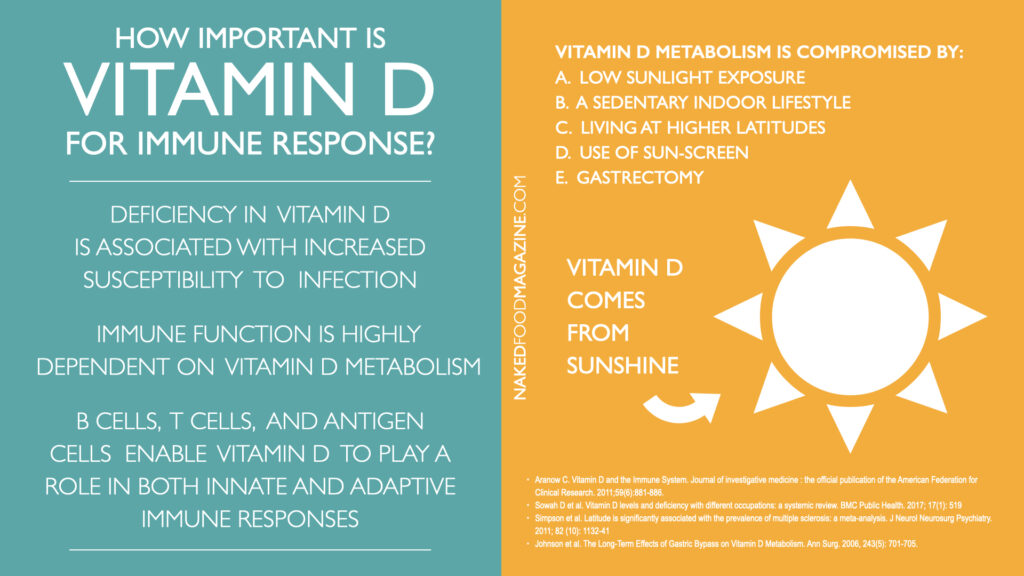Can the quarantine affect the absorption and metabolism of Vitamin D in the human body and inhibit essential immune response to infections?
Vitamin D is an essential nutrient for human health. The following is a short summary of what it is, how much we need, how it works, and how its deficiency affects the immune response.
What is Vitamin D?
Essential production of Vitamin D within the human body occurs with natural sun exposure during the summer months.
How much do we need?
The Minimal Erythemicdose Dose (MED) is the level of exposure to sun that causes the skin to become slightly pink, after which 10,000-20,000 IU vitamin D is released into circulation within 24 hours. For people who live in northern latitudes, vitamin D requirements in winter are met with stored vitamin D from exposure in the summer. An average of 30-70 ng/mL is optimal for bone health, tissue health, and immune health among others.
What does Vitamin D do?
Vitamin D is a main prerequisite to the absorption of calcium and phosphorous from the intestines and is therefore important in the remineralization of the bones. It also helps to regulate blood clotting, optimizes the function of the nerves and muscles, and affects the skin, pancreas, glandular function, and immune system.
How important is Vitamin D for Immune response?
Immune cell function is highly dependent on vitamin D metabolism because receptors are present on various immune cells such as B cells, T cells, and antigen presenting cells. These enable vitamin D to play a role in both innate and adaptive immune response.
Deficiency in vitamin D is associated with increased susceptibility to infection.1
Vitamin D metabolism may be compromised by a number of environmental factors including low sunlight exposure especially in winter, a sedentary indoor lifestyle,2 living at higher latitudes,3 use of sunscreen, and gastrectomy (surgical removal of all or part of the stomach).4
Vitamin D metabolism is also dependent on a number of enzymes. Even if we are exposed to sufficient UVB light to synthesize Vitamin D in the skin, the enzyme 7-dehydrocholesterol reductase can convert that 7-dehydrocholesterol to cholesterol, potentially affecting circulating vitamin D levels. Those who are dark-skinned, may be more prone to vitamin D insufficiency/deficiency, low immunity, frequent infections, and risk of cancer.
Those with liver5 or kidney6 disorders may experience impairment in the vitamin D pathway and be even more vulnerable. Vitamin D deficiency can also perpetuate existing problems and increase the risk of complications. In addition, certain pathogens can also disrupt vitamin D metabolism.

Supplementation vs. natural sunlight?
- Unlike vitamin D produced in the skin, there is the potential that vitamin D from supplements and fortificants could build up to toxic levels in the body.
- Vitamin D produced by skin remains in circulation 2-3 times longer than when taken as supplement. Taken in supplement form 100 IU of vitamin D only increases plasma levels less than 1 ng/mL.
References
[1] Aranow C. Vitamin D and the Immune System. Journal of investigative medicine : the official publication of the American Federation for Clinical Research. 2011;59(6):881-886. [2] Sowah D et al. Vitamin D levels and deficiency with different occupations: a systemic review. BMC Public Health. 2017; 17(1): 519 [3] Simpson et al. Latitude is significantly associated with the prevalence of multiple sclerosis: a meta-analysis. J Neurol Neurosurg Psychiatry. 2011; 82 (10): 1132-41 [4] Johnson et al. The Long-Term Effects of Gastric Bypass on Vitamin D Metabolism. Ann Surg. 2006, 243(5): 701-705. [5] Iruzubieta P et al. Vitamin D deficiency in chronic liver disease. World Journal of Hepatology. 2014;6(12):901-915. [6] Williams S et al. Vitamin D and chronic kidney disease. Ethn Dis. 2009; 19 (4 Suppl 5): S5-8-11.
Image by Tumisu
























